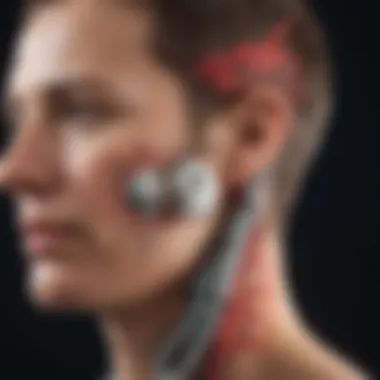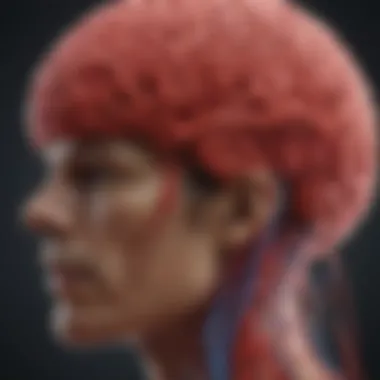Understanding Carotid Transcranial Doppler Techniques


Intro
Carotid transcranial Doppler (TCD) has emerged as a vital tool in the field of neurovascular diagnostics. This non-invasive imaging technique provides real-time assessment of cerebral blood flow, critical for understanding various neurological conditions. The ability to evaluate the dynamics of blood flow in the brain's vasculature allows for enhanced clinical decision-making. The importance of TCD lies not only in its technical capabilities but also in its applications across numerous clinical scenarios.
This article will delve into the mechanisms behind carotid TCD, explore its diverse applications in diagnosing neurological disorders, and investigate its broader implications in patient management. Whether you are a student, researcher, educator, or healthcare professional, understanding the nuances of TCD is essential for keeping pace with advances in neurodiagnostics.
Key Findings
Major Results
Clinical studies have demonstrated that TCD is effective in monitoring patients with various neurological diseases, including stroke, vasospasm, and transient ischemic attacks (TIAs). Results indicate a high sensitivity in detecting alterations in cerebral blood flow, making TCD an invaluable tool in both acute and chronic settings.
TCD can indicate the presence of emboli, assess hemodynamic changes, and evaluate collateral circulation. Its utility is evident in conditions like carotid artery stenosis, where the evaluation of cerebral perfusion can directly influence management strategies. The findings also suggest that TCD can serve as a prognostic indicator in some cases, further solidifying its role in clinical practice.
Discussion of Findings
The implications of TCD findings are profound. Clinicians can make informed decisions based on the blood flow parameters obtained through TCD. Additionally, the need for advanced imaging modalities, such as MRI or CT angiography, may be reduced as TCD offers timely results during critical phases of patient management. However, it is important to acknowledge that while TCD is powerful, it is best used complementarily with other diagnostic tools.
Methodology
Research Design
Research involving carotid TCD often employs a combination of clinical trials and observational studies. This mixed approach allows researchers to gather extensive data on patient outcomes while assessing the technique's efficacy in varied scenarios.
Data Collection Methods
Data collection regarding TCD typically involves measuring parameters such as mean flow velocity, pulsatility index, and the presence of embolic signals. These measurements help in establishing a clear profile of cerebral hemodynamics. The process often includes a thorough patient history and examination alongside TCD assessments, ensuring a comprehensive understanding of each case's context.
"Carotid transcranial Doppler is not just a tool; it is a window into the hemodynamics of the cerebral vasculature."
The trends observed in the collected data highlight the role of TCD in managing stroke risk and guiding treatment decisions, making it a critical asset in neurovascular care.
Preface to Carotid Transcranial Doppler
Carotid transcranial Doppler (TCD) is a critical tool in the field of neurovascular diagnostics. It offers an echo of the blood flow dynamics within the cerebral vasculature, making it invaluable for understanding various neurological disorders. As we delve into this topic, we will explore how TCD operates, its applications in clinical settings, and the implications it carries for patient management.
One key element is its non-invasive nature, allowing for real-time observation of blood flow velocities and patterns in the brain. This can significantly contribute to the diagnosis of conditions such as stroke, transient ischemic attacks, and other cerebrovascular disorders. Moreover, understanding TCD aids healthcare professionals in making informed decisions about patient treatment plans and interventions.
It is also important to consider the evolution of TCD technology. Improvements in equipment and methodologies have enhanced the accuracy and reliability of the results. With these advancements, TCD is not just a passive observational method but an active component in the management of patients with neurovascular diseases. In this section and the following ones, we will thoroughly examine the definitions, historical context, and technical aspects of carotid transcranial Doppler, laying a solid foundation for readers.
"With TCD, the ability to monitor cerebral blood flow in real time has profoundly changed the approach to ischemic conditions and surgical interventions."
As we proceed, it will become evident how TCD is a fusion of historical development and modern technology, showcasing its importance in contemporary medical practice.
Definition of Carotid Transcranial Doppler


Carotid transcranial Doppler is a diagnostic ultrasound technique that measures the blood flow in the brain. It does so by sending ultrasound waves into the cranial cavity, which bounce off the red blood cells moving in the arteries. The returning waves are analyzed, providing valuable information about the velocity and direction of blood flow. This data is critical for diagnosing various cerebrovascular conditions and assessing the overall health of the brain’s blood supply.
Historical Context and Evolution
The journey of carotid transcranial Doppler began in the 1980s when researchers first started applying Doppler ultrasound technology to investigate cerebral circulation. Initially, the method had limitations related to equipment sensitivity and operator skill. Over time, advances in technology, including the development of more sophisticated ultrasonic devices, have significantly improved TCD's effectiveness.
By the 1990s, TCD became more widely recognized in clinical practice, particularly in neurocritical care settings. Studies began to delineate its role in diagnosing and monitoring conditions like vasospasm after subarachnoid hemorrhage and assessing cerebral autoregulation.
In recent decades, ongoing research has led to enhanced methodologies, ensuring TCD can provide consistent and reliable results. Today, it stands as a cornerstone in the evaluation of cerebral hemodynamics, cementing its place in the diagnostic arsenal of neurologists and vascular specialists.
Technical Aspects of Carotid Transcranial Doppler
Understanding the technical aspects of carotid transcranial Doppler (TCD) is fundamental in grasping how this technique operates within neurovascular diagnostics. The effectiveness of TCD relies on precise principles, robust equipment, and a well-defined procedure. Each of these elements contributes significantly to its applications in clinical settings.
Fundamental Principles of Doppler Ultrasound
Doppler ultrasound utilizes sound waves to measure the movement of blood within blood vessels. It operates on the principle of frequency shift, which occurs when sound waves encounter a moving object— in this case, red blood cells. As the cells move towards the transducer, the frequency of the reflected sound waves increases. Conversely, as they move away, the frequency decreases.
This phenomenon is critical for assessing cerebral blood flow. The technique allows for real-time visualization of blood flow dynamics and provides quantitative measurements that help in monitoring various neurovascular conditions. The continuous wave Doppler and pulsed wave Doppler are the two main modalities used, each offering unique advantages depending on the specific diagnostic need.
Equipment and Instrumentation
The accuracy and reliability of TCD directly depend on the quality of the equipment used. Key components include:
- Ultrasound Transducer: It is responsible for sending and receiving sound waves. High-frequency transducers are preferred for better resolution.
- Signal Processing Unit: This component amplifies the received signals, filtering out background noise, and presenting it in a comprehensible form.
- Computer Software: It is essential for analyzing and visualizing the TCD data, often providing waveforms and numerical values related to blood flow velocity.
- Calibration Equipment: Regular apparatus calibration is necessary to ensure precision in measurements, improving diagnostic confidence.
The integration of advanced technology into TCD systems has enhanced its performance, allowing for more detailed and accurate assessments.
Procedure for Conducting TCD
Performing TCD requires a structured approach to maximize data accuracy and patient comfort. The procedure typically involves the following steps:
- Patient Preparation: The patient is positioned comfortably. It is crucial to ensure that the head and neck are properly aligned to facilitate access to the temporal windows, where the ultrasound will be applied.
- Transducer Application: A coupling gel is applied to the transducer to ensure optimal sound wave transmission. The transducer is then placed on the patient's scalp at specific sites, primarily around the temporal and occipital areas.
- Data Acquisition: The technician activates the Doppler system, allowing it to send sound waves into the cranial cavity. The technician must closely monitor the signal and make adjustments as needed for optimal visualization of blood flow.
- Waveform Analysis: Once the readings are acquired, they are analyzed for understanding the cerebral circulation. Variations in blood flow velocity can indicate various pathologies, necessitating careful interpretation.
- Post-Procedure Analysis: After the procedure, collected data undergoes further analysis. This data is documented and interpreted by a trained healthcare professional to make the informed diagnosis.
By following these steps, TCD can effectively assess brain hemodynamics, aiding in early detection and management of cerebrovascular issues.
Clinical Applications of Carotid Transcranial Doppler
The clinical applications of carotid transcranial Doppler (TCD) are numerous and have transformed how clinicians assess neurovascular conditions. Using this technology, healthcare professionals can gain real-time insights into cerebral blood flow dynamics, helping inform diagnoses and treatment plans. TCD helps in both diagnostics and monitoring of patients, making it a versatile tool in clinical practice. Understanding these applications can aid clinicians in enhancing patient care, ultimately leading to better health outcomes.
Assessment of Cerebral Blood Flow
One major application of carotid transcranial Doppler is the assessment of cerebral blood flow. By measuring flow velocity in major cerebral arteries, clinicians can evaluate whether sufficient blood is reaching the brain. This is particularly crucial in conditions where blood supply may be compromised, such as ischemic strokes.
TCD can help identify elevations or reductions in flow velocities which can indicate various pathologies. For example, a significant increase in blood flow velocity might suggest the presence of a narrowing or stenosis, while reduced velocities can be a sign of compromised blood supply due to other underlying conditions.
Carotid transcranial Doppler acts as a non-invasive method for monitoring cerebral blood flow, providing immediate feedback essential for patient management.


Detection of Cerebrovascular Disorders
TCD is instrumental in detecting cerebrovascular disorders. For instance, it can help identify abnormalities such as emboli, which are critical for early diagnosis of conditions like strokes. By observing the microemboli detected during the procedure, healthcare providers can determine if the source is systemic or localized within the carotid arteries.
Moreover, TCD has been found effective in diagnosing vasospasm, a dangerous condition that can lead to delayed cerebral ischemia following subarachnoid hemorrhage. The ability to monitor flow changes in real-time makes TCD a valuable asset in emergency and intensive care settings.
Monitoring during Surgical Procedures
Another important application of carotid transcranial Doppler is its use in monitoring patients during surgical procedures. It helps assess cerebral perfusion during surgeries that pose a risk of cerebral ischemia, such as carotid endarterectomy or cardiac surgery.
TCD allows for immediate detection of any perfusion issues, enabling surgeons to make swift decisions and mitigate risks. For instance, if a drop in blood flow is observed, an immediate response can be initiated to restore circulation. This real-time monitoring emphasizes the role of TCD as an essential tool for enhancing patient safety in surgical environments.
Interpreting Carotid Transcranial Doppler Results
Interpreting the results from carotid transcranial Doppler (TCD) is essential for making informed clinical decisions regarding neurovascular health. The outcomes generated by TCD offer insights into cerebral blood flow dynamics, which is crucial for detecting abnormalities like stenosis or occlusion. Understanding these results empowers clinicians to provide personalized treatment plans for their patients, ensuring timely intervention when necessary.
Understanding TCD Waveforms
TCD waveforms represent the Doppler signals detected from cerebral vessels. Each waveform provides information on the velocity of blood flow, which correlates with specific physiological conditions. Key features of the waveforms include:
- Peak Systolic Velocity (PSV): Indicates the maximum blood flow speed during systole. Elevated PSV can signal significant stenosis.
- End-Diastolic Velocity (EDV): Measures the velocity of blood flow at the end of diastole. This data helps assess vascular resistance and perfusion levels.
- Pulsatility Index (PI): A ratio that indicates the variability of blood flow. An increased PI can suggest heightened vascular resistance, often seen in conditions like arterial occlusion.
These waveforms are analyzed in context, considering factors such as patient history and other clinical signs. Professional interpretation requires both expertise and experience to accurately assess the clinical implications of the findings.
Identifying Abnormal Patterns
Identifying abnormal patterns in TCD results is crucial for diagnosing cerebrovascular disorders. Anomalies may manifest as unexpected waveforms or velocities that deviate from normal ranges. Common abnormal findings include:
- High PSV: This often indicates a significant stenosis. A PSV greater than 125 cm/s typically necessitates further evaluation.
- Lateralization: Discrepancies between the left and right sides can reveal occlusion or asymmetrical flow, which may indicate underlying pathology.
- Reversed Flow: Bidirectional flow in the arteries can signify critical stenosis or even thrombosis.
Accurate identification of these patterns leads to appropriate interventions. This recognition must also be complemented with clinical correlation to ensure that interpretations are aligned with actual patient conditions.
Correlation with Other Imaging Techniques
To enhance diagnostic confidence, correlating TCD results with other imaging modalities is important. While TCD provides functional data on blood flow, imaging techniques like magnetic resonance angiography (MRA) or computed tomography angiography (CTA) provide structural information about cerebral vessels. When integrated, these approaches yield a comprehensive view of a patient’s vascular status.
For instance:
- MRA and CTA can reveal the location and severity of stenosis or aneurysms, whereas TCD assesses the physiological impact by monitoring blood flow changes.
- Combining TCD with CT scans can help evaluate the risk of stroke more effectively by illustrating acute changes in blood flow caused by occlusions detected on structural imaging.
The correlation between these techniques not only aids in diagnosis but also helps guide therapeutic strategies. Early intervention in response to findings can mitigate risks associated with cerebrovascular diseases.
Close collaboration among imaging specialists and clinicians is vital for thorough interpretation and to optimize patient care.
Advantages and Limitations of TCD


Carotid transcranial Doppler (TCD) is a notable tool in neurovascular diagnostics. Understanding its advantages and limitations is essential for healthcare professionals. These insights help in the accurate assessment of cerebrovascular conditions and guide management strategies.
Benefits of Non-Invasive Evaluation
One of the primary advantages of TCD is its non-invasive nature. Unlike other imaging techniques, TCD does not require ionizing radiation or the use of contrast agents. This is particularly beneficial for populations such as patients with renal impairment or pregnant women, where traditional imaging may pose risks. Some key benefits include:
- Safety: The low risk of complications makes TCD suitable for repeated assessments.
- Ease of Use: The technique can be performed at the bedside or in an outpatient setting, enhancing accessibility for patients.
- Real-time Monitoring: TCD allows for immediate evaluation of blood flow dynamics, which is crucial during surgical or interventional procedures.
"The non-invasive aspect of TCD simplifies the evaluation process and minimizes patient discomfort, making it a preferred choice in many clinical settings."
Limitations in Diagnostic Accuracy
While TCD offers many advantages, it also has limitations worth noting. The accuracy of TCD results can be influenced by several factors, including:
- Operator Dependency: The skill and experience of the operator can significantly affect the accuracy of TCD readings. Misinterpretation can lead to incorrect assessments.
- Patient Factors: Certain physical conditions, like transcranial windows variability, may limit the examination, leading to incomplete or inadequate data.
- Limited Spatial Resolution: TCD primarily evaluates large intracranial arteries. Smaller vessels may not be adequately assessed, potentially missing relevant pathological conditions.
Recognizing these limitations is essential for practitioners. Continuous training and adherence to standardized protocols can help mitigate these challenges, ensuring TCD remains an effective tool in the clinician's arsenal.
Current Research and Future Directions
Current research in carotid transcranial Doppler (TCD) technology reveals significant advancements that could enhance its application in clinical settings. Understanding these developments is essential, as they provide deeper insights into neurovascular diagnostics and patient management. As TCD becomes more refined, it shows promise not only in established uses but also hints at new avenues in which it can be beneficial.
Recent Advances in TCD Technology
Recently, several compelling advancements in TCD technology have emerged. The introduction of portable and compact TCD devices has made it easier to conduct assessments outside traditional clinical settings. These devices can be utilized in emergency departments or at patients' homes, allowing for real-time monitoring of cerebral blood flow. Moreover, digital signal processing techniques have improved the accuracy of waveforms and velocity measurements, allowing for a more nuanced understanding of hemodynamics in cerebral circulation.
"The ability to monitor cerebral blood flow on-the-go can heavily influence timely interventions, leading to better patient outcomes."
Integrating artificial intelligence into TCD analysis presents another exciting trend. Algorithms can now learn from vast datasets, identifying patterns and anomalies faster than human analysis alone. This efficiency could potentially decrease the time from assessment to diagnosis. Other advancements also include high-frequency ultrasound techniques that can enhance resolution and provide more detailed images of the cranial structures.
Potential for New Clinical Applications
The future of carotid TCD appears promising due to the potential for new clinical applications. For instance, one area of interest is using TCD monitoring in neurocritical care. Continuous assessment of blood flow in critically ill patients could allow clinicians to make instantaneous decisions based on real-time data. Early detection of complications such as cerebral ischemia is crucial in these settings and could be significantly improved through TCD.
Beyond critical care, researchers are investigating the use of TCD in predicting stroke risk in asymptomatic individuals. Early diagnosis of altered cerebral perfusion may provide a vital window for preventive measures. Additionally, TCD could be useful in evaluating the efficacy of treatments for various neurological disorders, facilitating personalized therapeutic strategies.
In summary, the ongoing research and advances related to carotid transcranial Doppler technology underscore its evolving role in the medical field. Emphasizing its potential applications, both established and novel, could lead to enhanced patient outcomes and better management of neurological health.
Ending
The conclusion serves as a critical segment of this article on carotid transcranial Doppler, encapsulating the main insights and their relevance to neurovascular diagnostics. Reflecting on the advancements in the utilization of TCD, the value of understanding its techniques and applications cannot be overstated. The insights gained from this technology influence how conditions such as stroke, cerebral vasospasm, and other cerebrovascular diseases are diagnosed and managed.
Summary of Key Takeaways
- Carotid transcranial Doppler is a non-invasive technique for evaluating cerebral blood flow.
- It plays a crucial role in detecting abnormal patterns and assessing risk factors for neurological conditions.
- Recent advancements in technology have enhanced the accuracy and utility of TCD in clinical practice.
- The integration of Doppler ultrasound with other imaging modalities can provide a comprehensive view of brain health.
Implications for Clinical Practice
The application of carotid transcranial Doppler in clinical settings presents several implications:
- Timely intervention: Early detection of cerebrovascular disorders allows for prompt management, which can significantly improve patient outcomes.
- Non-invasive nature: Being less invasive makes TCD preferable for many patients, lowering the risk of complications associated with traditional imaging techniques.
- Enhanced decision-making: Insights gathered from TCD can inform treatment decisions, guiding healthcare professionals in tailoring interventions specific to individual patient needs.
In summary, the ongoing exploration and application of carotid transcranial Doppler encapsulate a vital aspect of contemporary neurovascular investigation, affirming its significance in enhancing patient care and outcomes.



